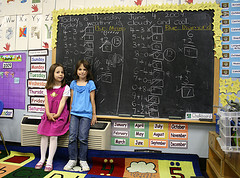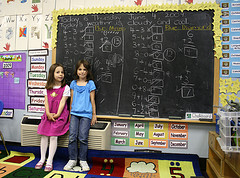It’s the perennial question from students of all ages: “When will I use this stuff?” So when tutor, Ryan faced this query (probably for the upteenth time), he took to the streets to find the answer. What he found is in the video below:
And of course I have some thoughts — for teachers and students.
It is absolutely true that series (that’s what the funny looking E — an uppercase sigma — means in this problem) are not the stuff of ordinary folks in non-science fields. But they’re not as difficult as they seem. It’s the notation that’s confusing.
Skip this part, if you don’t really want to do any algebra today.
A series is just the sum of a sequence (or list) of numbers. That’s it. Nothing more, nothing less. So when you have
sum{n=1}{7}{3n-1}
you’re simply saying, “Find the sum of the first 7 values of 3n-1, where the first value of n is 1.” In other words: 2 + 5 + 8 + 11 + 14 + 17 + 20 = 77.
Now back to my opinions.
Okay, so I don’t need to know what a series is in order to visit the grocery store or get a good deal on a car or even figure out how much I earned this year over last year. But here’s what I wish some of those folks who were interviewed for this video had been able to say:
“That funny-looking E is a Greek letter, right?”
“Doesn’t this have to do with adding things together?”
“Hey, I dated a girl from {Sigma}{Sigma}{Sigma} once!”
And second, this tutor did pick a humdinger of a problem to focus on. Series (and their brothers, sequences) are not the main focus of any mathematics course. But honestly, they wouldn’t be taught if they weren’t useful somewhere. And boy-howdy are they useful!
So, here are a few ways that real people do use series in their real jobs (courtesy of Algebra Lab and Montana State University:
1. Architecture: “An auditorium has 20 seats on the first row, 24 seats on the second row, 28 seats on the third row, and so on and has 30 rows of seats. How many seats are in the theatre?”
2. Business: “A company is offering a job with a salary of $30,000 for the first year and a 5% raise each year after that. If that 5% raise continues every year, find the amount of money you would earn in a 40-year career.”
3. Investment Analysis: “A person invests $800 at the beginning of each year in a superannuation fund. Compound interest is paid at 10% per annum on the investment. The first $800 was invested at the beginning of 1988 and the last is to be invested at the beginning 2017. Calculate the total amount at the beginning of 2018.”
4. Physics: “The nucleii of a radioactive isotope decay randomly. What is the total number of nucleii after a given period of time?”
And this brings me to some additional news of the week. Sol Garfunkel (Consortium for Mathematics and Its Applications) and David Mumford (emeritus professor of mathematics at Brown) made a bit of a splash on Wednesday, with an editorial in the New York Times: How to Fix Our Math Education.
Their proposal is that we teach tons of math that applies to everyday life — and focus on those applications. (Yay!) And we ditch “highly conceptual” math for folks who won’t need it for their jobs. (Boo!)
Hopefully, you’ve already identified the problem: How do we know if a kid won’t decide to go into physics or engineering or high school math education? Hell, how do we even attempt to lure them into these fields, if they don’t see the math at all? (And by the way, physics, engineering and applied mathematics were recently identified as the top-paying degrees in the U.S.)
Look, I empathize with the student who isn’t interested in what any of the Greek letters mean in math class. And I think it’s true that most folks won’t use these skills at all after high school. (It is worth mentioning that everyone depends on series in their daily lives–they just don’t see the math.) But my response to the kid who asks, “What’s this good for?” is to tell him where it can be applied.
And if he says he won’t be going into any of those fields, I would say, “Suck it up, cupcake, because you’re too darned young to know for sure.”
Please share your thoughts in the comments section. Do you agree that these concepts should be taught in high school, even though most kids won’t use them in their everyday lives? How do you think we should encourage more students to go into science, technology, engineering and math (STEM) fields?




